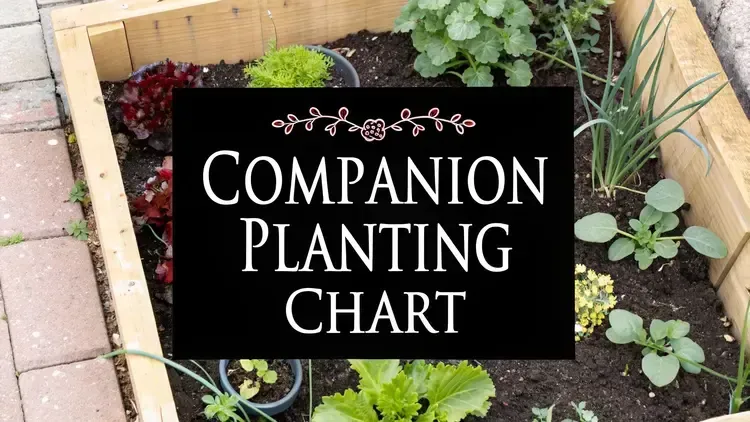
A Guide to the Ultimate Companion Planting Chart
A Guide to the Ultimate Companion Planting Chart
A companion planting chart is one of a gardener's best-kept secrets. It’s an age-old strategy for pairing plants that help each other thrive, creating a little ecosystem that practically runs itself. When you group plants that mutually benefit one another, you get natural pest control, better soil, and a bigger harvest without a bunch of extra chemicals.
What Is Companion Planting and Why It Matters
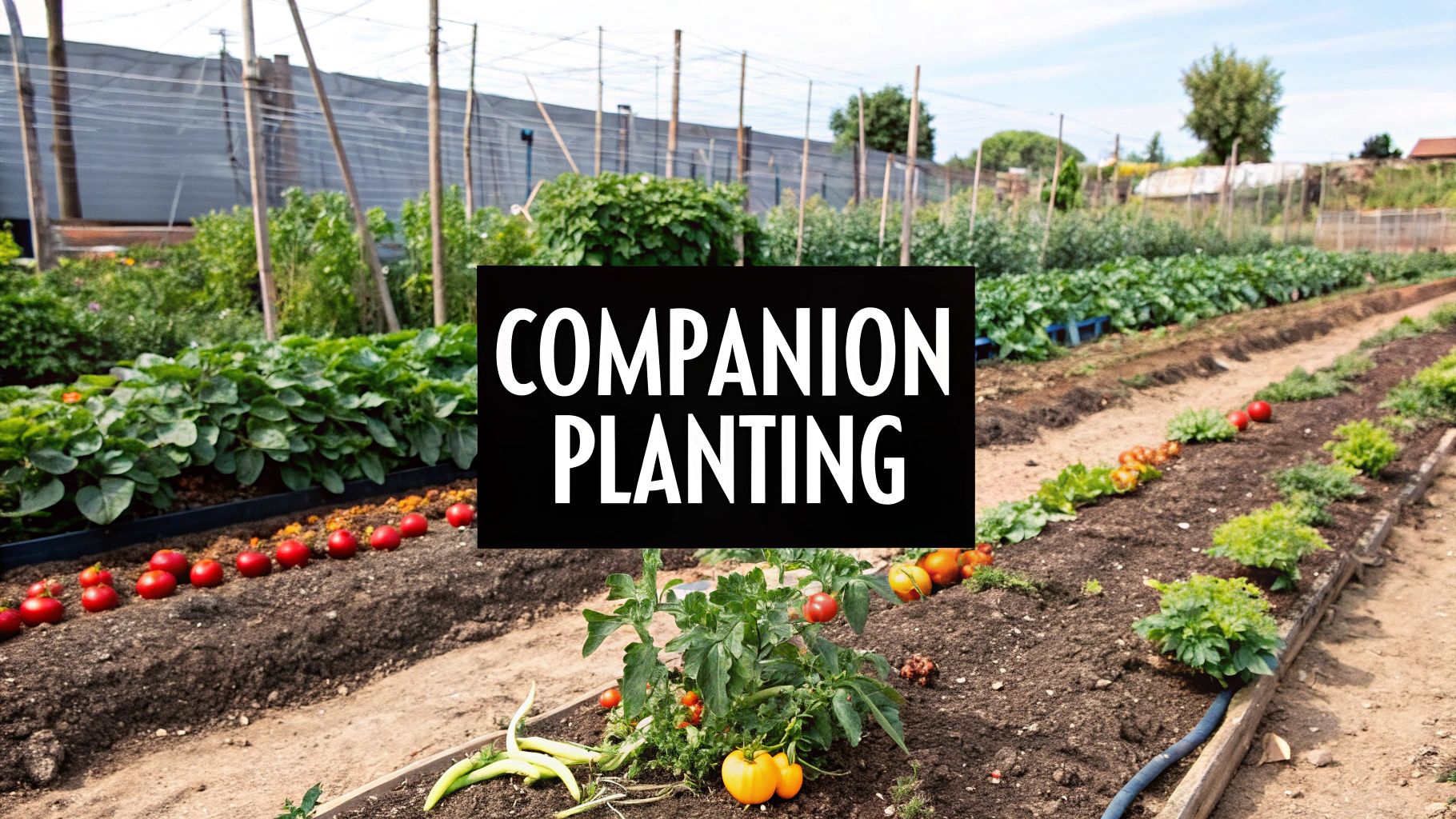
Companion planting isn’t just garden folklore—it’s the science of creating plant partnerships that build a resilient garden. At its heart, the practice is about creating a diverse ecosystem where plants support each other, just like they do in nature. Instead of a single crop that acts like a dinner bell for pests, a garden filled with smart companions can defend itself.
This approach has deep roots, with principles you can see in ancient gardens worldwide. The most famous example is the “Three Sisters” method used by Indigenous peoples across North America. They grew corn, beans, and squash together in a perfect symbiotic relationship. The corn gave the beans a natural trellis, the beans fixed nitrogen in the soil for everyone, and the squash spread out to shade the ground, keeping weeds down and moisture in. You can learn more about its history and global origins on Wikipedia.
Key Benefits of Companion Planting
Knowing why certain pairings work is the first step to using a companion planting chart well. Before you start mapping out your beds, it’s helpful to understand the real advantages. If you need a refresher on laying out your space, our guide on garden planning for beginners is a great place to start.
Here are the main benefits you’ll see:
Natural Pest Control: Many aromatic herbs, like basil and rosemary, have strong scents that confuse or flat-out repel common garden pests. Planting them near vulnerable vegetables is like giving them a fragrant bodyguard.
Attracting Beneficial Insects: Certain flowers, such as borage and marigolds, are magnets for pollinators and predatory insects. They'll bring in ladybugs and lacewings that happily feast on aphids and other pests.
Improving Soil Health: Some plants, especially legumes like beans and peas, are experts at pulling nitrogen from the air and "fixing" it in the soil. This makes a vital nutrient readily available for their neighbors.
Maximizing Garden Space: You can make the most of every square inch by pairing tall, sun-loving plants with low-growing, shade-tolerant ones. This is a game-changer in smaller gardens or raised beds where every bit of soil counts.
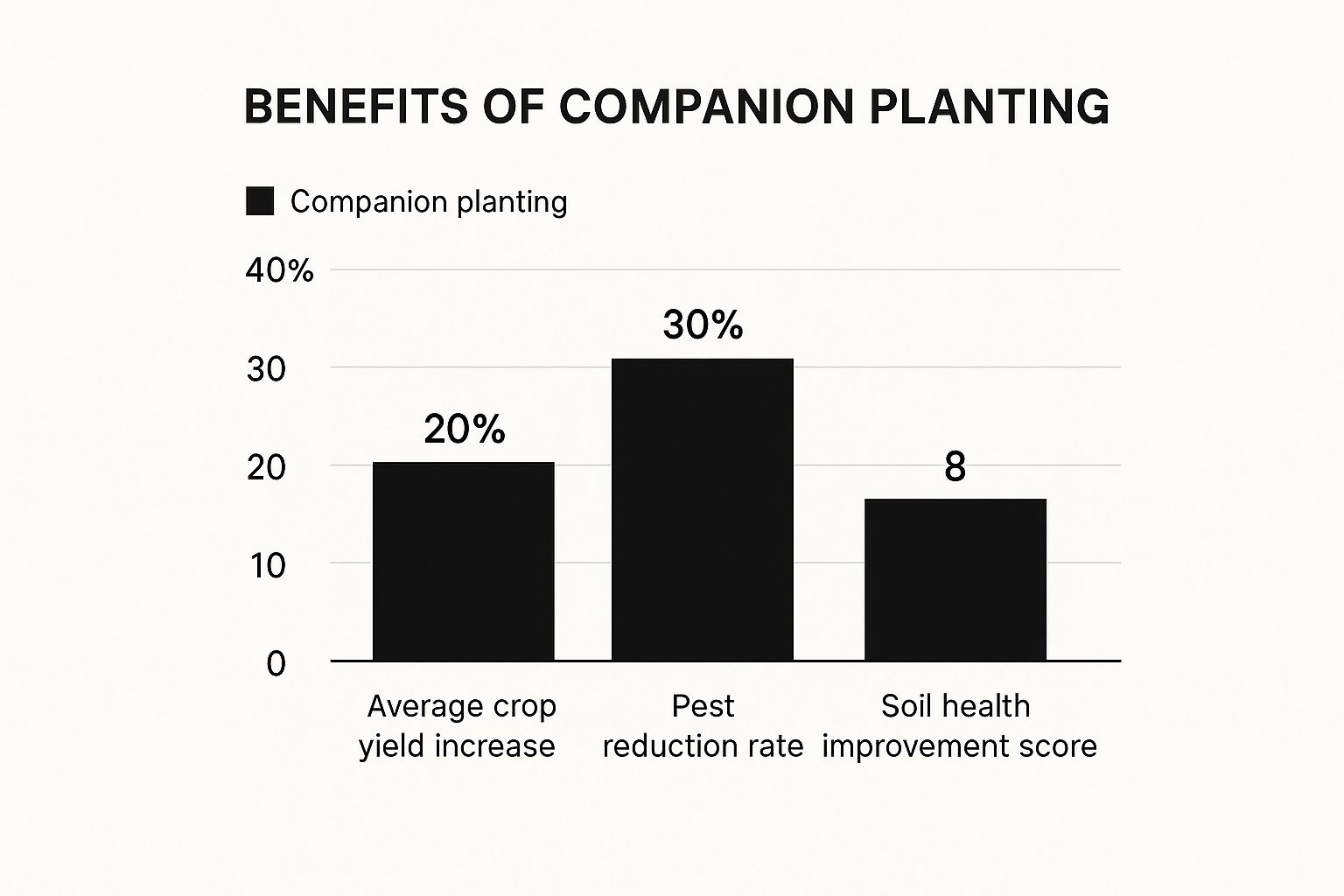
As you can see, the numbers don't lie. When you get these plant partnerships right, the results are tangible—we're talking bigger harvests, fewer pests, and soil that gets better every season.
Your Complete Vegetable Companion Planting Chart
Alright, this is the heart of the guide—the part you'll come back to time and again. I've put together a comprehensive companion planting chart designed to be as straightforward as possible. Think of it as a quick-reference cheat sheet for your garden.
How to Use This Chart
Using this reference chart is simple. First, find the main vegetable you're planning to grow in the left-hand column. The next two columns list its "Friends" (the plants that help it thrive) and its "Foes" (the ones that cause problems). Finally, the last column gives you the main reason for that relationship, so you understand the strategy behind the pairing.
Gardener's Insight: Remember, companion planting is a powerful tool, but it isn't a silver bullet. It delivers the best results when you combine it with other solid gardening habits like good watering, smart crop rotation, and building healthy soil.
For instance, if you're planting tomatoes, you'll see basil listed as a "Friend." That's because basil is fantastic at repelling tomato hornworms. On the other hand, corn is a "Foe" since both plants are magnets for the same destructive corn earworm.
Vegetable Companion Planting Quick Reference
Below is a quick-lookup table I've created to cover some of the most popular garden vegetables. It’s designed to give you fast answers when you're out in the garden with a trowel in one hand and a seed packet in the other.

This table covers the basics for many common garden staples. When you're ready to get more specific with other crops, especially fruits, you can dive deeper into our companion planting watermelon guide. It offers specialized advice for that summertime favorite.
Ultimately, strategic planting is about creating a garden ecosystem that works with nature, making your job easier and your harvests more abundant.
Using Herbs for Natural Garden Protection
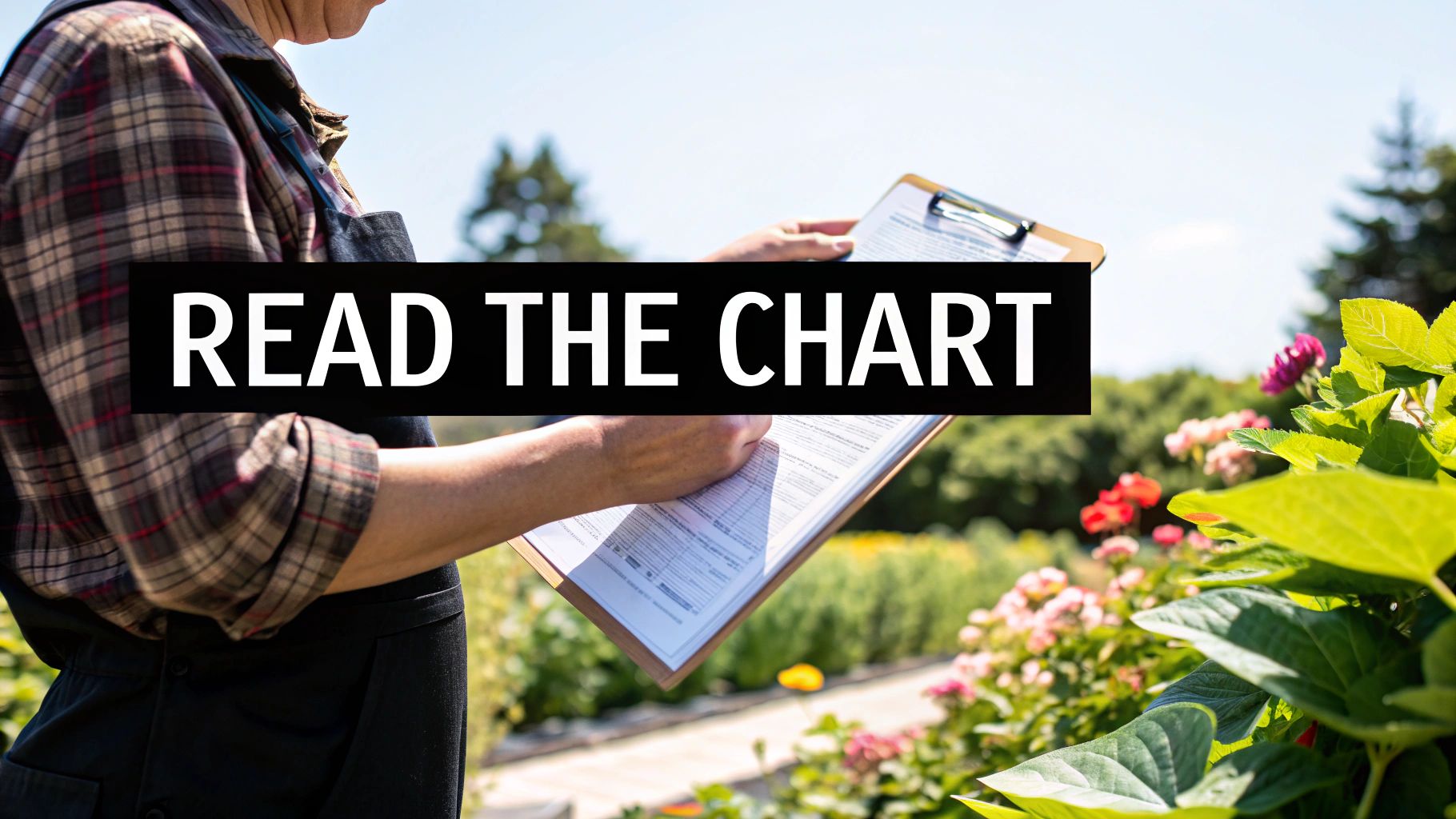
Herbs are the unsung heroes of any companion planting chart. I've learned over the years that they do far more than just look pretty in a dedicated bed. When you weave them throughout your vegetable rows, they create a fragrant, protective shield for your more vulnerable plants.
Their main superpower? Those strong, aromatic oils. The scents they release can actively confuse and repel many of the most common garden pests. It’s a simple, organic strategy that creates a kind of "sensory camouflage," making it a real challenge for insects like aphids or tomato hornworms to even find their favorite meal.
Aromatic Herbs for Pest Repellents
Many herbs have a well-earned reputation for deterring specific insects, which makes them fantastic bodyguards for your prized crops. It's all about strategic placement.
Here are a few of the essentials I always have in my garden and what they do:
Basil: This is the classic companion for tomatoes. It’s known to repel tomato hornworms and whiteflies, and its strong scent is a powerful deterrent.
Rosemary: I like to plant this woody herb near my brassicas, like broccoli and cabbage. It really helps ward off the destructive cabbage moth.
Mint: Mint is aggressive, so I keep it in containers to prevent a garden takeover. That said, its pungent aroma is one of the best for repelling aphids. I’ll place pots of mint near susceptible plants like lettuce and carrots.
Pro Tip: As you walk through your garden, gently brush against the herbs. This releases a fresh wave of their essential oils, temporarily boosting their pest-repelling power and filling the air with a wonderful aroma.
Herbs That Attract Garden Allies
It's not just about pushing pests away. Some herbs are masters at inviting the "good guys" into your garden. When you let certain herbs flower, they provide crucial nectar and pollen for pollinators and predatory insects. These beneficial bugs are a cornerstone of any effective natural pest control strategy.
For instance, if you let dill and cilantro go to flower, you'll soon see ladybugs, lacewings, and parasitic wasps flocking to them. These predators are invaluable allies, as they actively hunt down aphids, mites, and other pests. Borage is another superstar here—it’s a magnet for bees, which helps ensure your squash and tomatoes get well-pollinated for a truly bountiful harvest.
Attracting Beneficial Insects to Your Garden
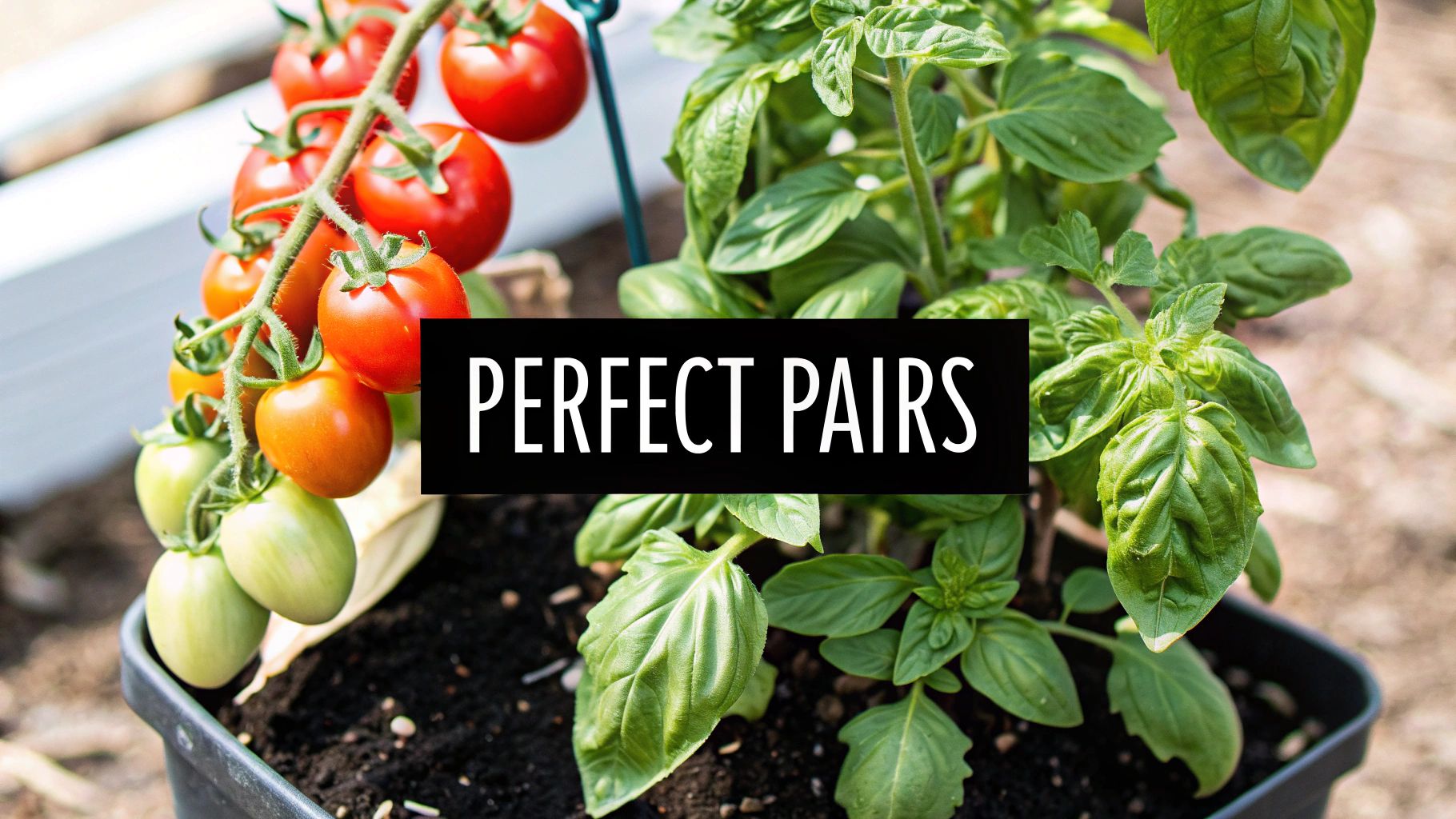
A truly resilient garden doesn't just fight off pests—it invites in the "good bugs" and works with nature. One of the most powerful ways to do this is by creating an insectary, which is just a dedicated habitat for beneficial insects. This is a big step beyond simply repelling pests; it's about building a permanent, welcoming home for garden allies like ladybugs, lacewings, and hoverflies.
These helpful predators are your best defense against aphids, mites, and other common troublemakers, but they won't stick around if there's nothing for them to eat. By planting specific flowers and herbs, you give them the nectar, pollen, and shelter they need to thrive and reproduce. Before you know it, you've created a self-regulating system of natural pest control.
This biological approach can dramatically cut down on the need for chemical sprays. In fact, studies have shown that intercropping certain plants can slash pest populations. One great example is planting marigolds with kale; it's proven to attract predatory syrphid flies and parasitic wasps, which then go to town on any aphids.
Best Plants for Your Insectary
To build an effective insectary, you want to focus on plants with small, easily accessible flowers that are packed with nectar and pollen. Think of these plants as a cafeteria and a nursery for your garden's little protectors.
Alyssum: This low-growing flower is a champ. It produces clusters of tiny white blossoms, offering a perfect food source for hoverflies, whose larvae are absolute machines when it comes to devouring aphids.
Yarrow: The flat-topped flower clusters on yarrow act like perfect little landing pads for ladybugs and parasitic wasps, giving them easy access to a quick nectar meal.
Cosmos: Cheerful and daisy-like, these flowers are magnets for lacewings. Lacewings are fantastic predators of aphids, caterpillars, and mites.
Dill and Fennel: If you let these herbs go to flower, they become hubs of activity for a huge range of beneficial insects, including ladybugs and predatory wasps.
Garden Tip: Don't just relegate these helpful plants to the border of your garden. The real magic happens when you weave them right into your vegetable beds. Tucking a cosmos plant near your beans or planting alyssum at the base of your tomatoes ensures your garden guardians are exactly where you need them most.
Common Companion Planting Mistakes to Avoid
Even with the best companion planting chart in hand, it’s easy to make a few simple mistakes that can set your garden back. I’ve seen it happen countless times. Thinking about what not to do is just as critical as knowing which plants to pair up. Getting this right is the difference between a thriving garden ecosystem and a patch of stressed-out plants.
One of the most common blunders I see is planting aggressive herbs like mint or oregano directly into a garden bed. While they’re fantastic for repelling pests, their root systems are invasive. If you don't contain them, they will quickly choke out their neighbors, stealing water, nutrients, and sunlight. It’s far better to plant them in pots and just place them near the vegetables you want to protect.
Another classic error is ignoring plant families. Grouping members of the same family too close together is like setting out a concentrated feast for their shared pests and diseases. For instance, putting tomatoes and potatoes side-by-side is asking for trouble since they are both nightshades susceptible to the same blight. One sick plant can quickly become a row of sick plants.
Mismanaging Your Garden’s Environment
Beyond just the pairings, many gardeners overlook the environment they're creating. Planting a sun-lover next to a tall, bushy companion that casts a huge shadow is a recipe for disappointment and stunted growth. You have to think about how the sun moves across your garden and make sure every plant gets what it needs.
It’s the same story with resources. Heavy-feeding crops like corn and squash are hungry plants. If you plant them together without seriously beefing up the soil with compost and nutrients, they’ll just fight each other for food, and neither one will reach its full potential.
A Note on What to Expect: It’s important to remember that companion planting is more of an art than a hard science. While many pairings have a long history of success, the results can vary. Your specific climate, soil, and the way you manage your garden all play a huge role. Scientific studies show mixed results, which tells us a companion planting chart is a guide, not a guarantee. You can find more on the complexities of companion planting effectiveness from people who have dug into the research.
At the end of the day, successful companion planting is all about balance and observation. Keep these four things in mind, and you'll be ahead of the game:
Aggressive Spreaders: Always, always contain plants known for taking over.
Plant Families: Mix things up. Don't create a monoculture buffet for pests.
Sun and Shade: Plan your layout like an architect, considering light and shadows.
Food and Water: Group plants with similar needs, or give your heavy feeders extra support.
Steering clear of these simple mistakes will help you turn your companion planting chart into a roadmap for a healthier, more productive garden.
Your Companion Planting Questions, Answered
Every gardener, whether you're just starting out or have years of dirt under your fingernails, runs into practical questions when putting a companion planting chart to use. Getting the details right—like spacing, garden type, and a few key terms—can be the difference between a thriving garden and a frustrating one. Let's tackle some of the most common questions I hear.
How close do companion plants actually need to be to help each other? This is probably the most frequent question, and the answer is: it depends on why you're pairing them.
For pest-repelling herbs like basil or rosemary, their aromatic oils are the magic. Planting them within 1-2 feet of a vegetable is usually close enough for their scent to confuse and deter pests. For things like living mulches or ground cover, you'll want to plant them according to their mature size so they fill in properly without choking out their neighbors.
Making It Work in Containers and Raised Beds
A lot of folks wonder if companion planting is just for big, in-ground gardens. Does it work in pots and raised beds? Absolutely. In fact, it’s even more critical in smaller spaces. When every inch counts, strategic pairings are your best tool for managing pests and making the most of limited resources.
A classic three-part container planting is a perfect example of this in action:
A "thriller" (the tall plant): Think of a staked tomato or a pepper plant providing height.
A "filler" (the mid-level plant): Tuck basil or chives around the base to repel pests and fill the space.
A "spiller" (the trailing plant): Let nasturtiums cascade over the edge to act as a trap crop for aphids.
This layered approach creates a tiny, self-sufficient ecosystem that makes smart use of a very small footprint.
Companion Planting vs. Crop Rotation: What's the Difference?
Finally, people often ask about companion planting versus crop rotation. It’s a great question because while they work together beautifully, they serve two very different purposes.
Key Distinction: Companion planting is about growing different plants together at the same time for immediate, in-season benefits. Crop rotation is about changing where you plant certain plant families from one season to the next as a long-term strategy for soil health and disease prevention.
Think of it like this: companion planting is how you build a healthy community in your garden this year. Crop rotation is how you ensure the entire neighborhood stays healthy for many years to come. Using both is the key to a truly resilient and productive garden.
At The Grounded Homestead, we believe that growing your own food should be a joyful and rewarding experience. For more tips, guides, and inspiration to help you on your journey, check out our resources at https://thegroundedhomestead.com.

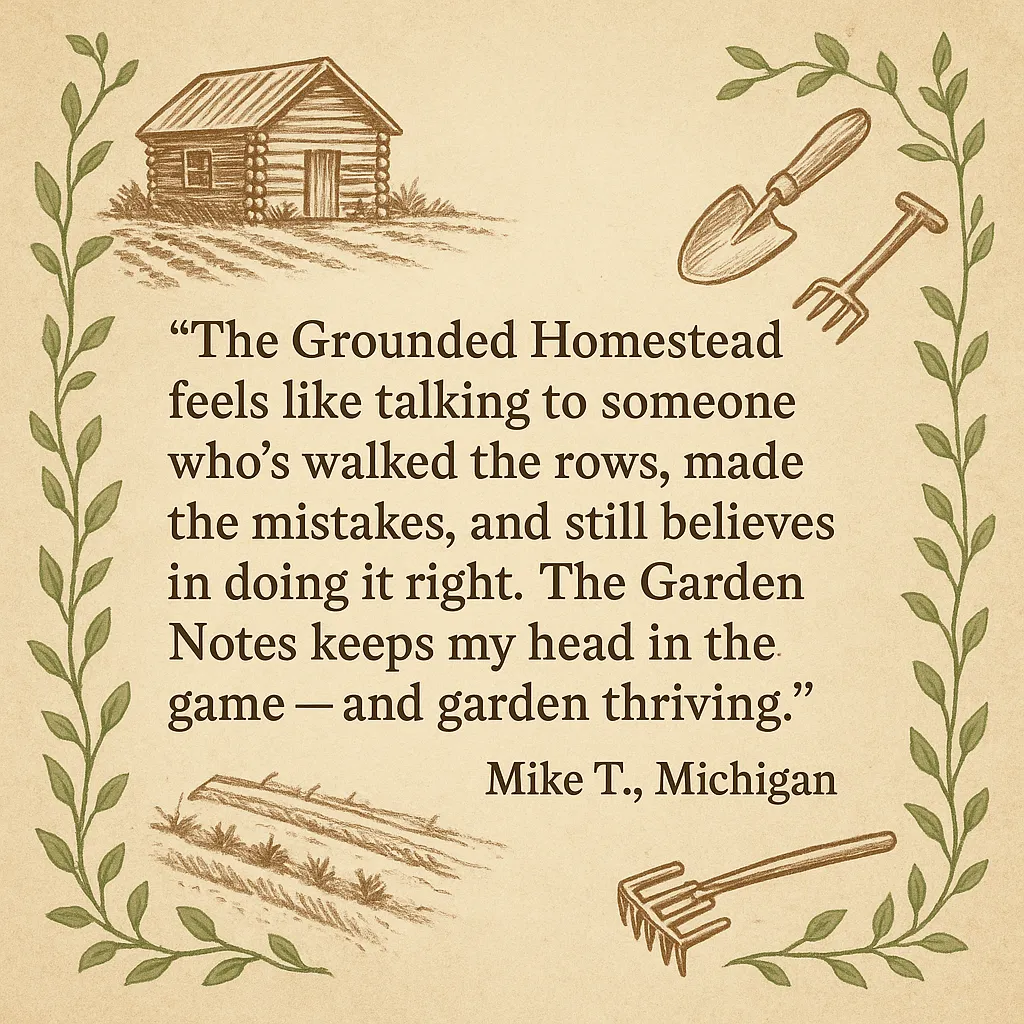
Facebook
Instagram
X
Youtube